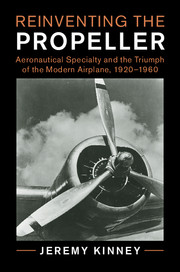Book contents
- Frontmatter
- Dedication
- Contents
- List of Figures
- List of Tables
- Preface
- Acknowledgments
- List of Abbreviations
- A Note on Terms
- 1 Introduction: The Propeller and the Modern Airplane
- 2 “The Best Propeller for Starting Is Not the Best for Flying”
- 3 “Engineering of a Pioneer Character”
- 4 A “New Type Adjustable-Pitch Propeller”
- 5 “The Propeller That Took Lindbergh Across”
- 6 “The Ultimate Solution of Our Propeller Problem”
- 7 No. 1 Propeller Company
- 8 A Gear Shift for the Airplane
- 9 Constant-Speed
- 10 “The Spitfire Now ‘Is an Aeroplane’ ”
- 11 A Propeller for the Air Age
- 12 Conclusion: The Triumph and Decline of the Propeller
- Essay on Sources
- Index
Preface
Published online by Cambridge University Press: 20 April 2017
- Frontmatter
- Dedication
- Contents
- List of Figures
- List of Tables
- Preface
- Acknowledgments
- List of Abbreviations
- A Note on Terms
- 1 Introduction: The Propeller and the Modern Airplane
- 2 “The Best Propeller for Starting Is Not the Best for Flying”
- 3 “Engineering of a Pioneer Character”
- 4 A “New Type Adjustable-Pitch Propeller”
- 5 “The Propeller That Took Lindbergh Across”
- 6 “The Ultimate Solution of Our Propeller Problem”
- 7 No. 1 Propeller Company
- 8 A Gear Shift for the Airplane
- 9 Constant-Speed
- 10 “The Spitfire Now ‘Is an Aeroplane’ ”
- 11 A Propeller for the Air Age
- 12 Conclusion: The Triumph and Decline of the Propeller
- Essay on Sources
- Index
Summary
When I was a small boy, my parents gave me a little wood airplane with a big red plastic propeller. Holding the fuselage in one hand, I turned the propeller to wind up the rubber band “engine.” The power of the rubber band spun the propeller and I could feel a breeze flow over my airplane until I let it go. If I did not wind enough, the airplane would jump and skid along the ground, unable to take off. If I wound too much, the propeller would “race” and the airplane would vibrate and careen out of control. I spent hours in our backyard learning how to wind the propeller so my airplane would fly straight and level.
During one of our many family visits to museums and air shows during my childhood, I got close to some of my favorite airplanes. One of those was the Curtiss Jenny, a fabric-covered biplane that the wandering barnstormers flew from town to town across America in the 1920s selling rides to brave and curious folks. As I looked at the Jenny's wood propeller, I could see a long, flat curve that moved all the way along its length, from the tip at one end, through the hub in the center, and on to the tip at the other end. This aerodynamic twist, called pitch, gave the propeller its shape and allowed it to turn the engine's power into thrust – the “breeze” created by my toy airplane – to propel the Jenny forward.
Another favorite was the Douglas DC-3 airliner from the 1930s. The DC-3 was a very different airplane than the Jenny. It was a sleek twin-engine monoplane capable of carrying twenty-one passengers. Unlike my toy airplane and the Jenny, each of its two propellers had three shiny metal blades that could change pitch in flight. When needed, the propellers generated a lot of thrust for takeoff and prevented “racing” as the DC-3 cruised through the sky. The technical transformation, or reinvention, of the airplane propeller – from the one found on the Jenny to the advanced design installed on the DC-3 – by a community of specialists and what it had to do with increasing the performance of aircraft over the course of the twentieth century is the focus of this book.
- Type
- Chapter
- Information
- Reinventing the PropellerAeronautical Specialty and the Triumph of the Modern Airplane, pp. xiii - xivPublisher: Cambridge University PressPrint publication year: 2017



